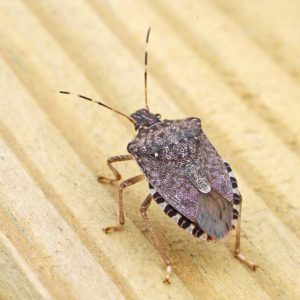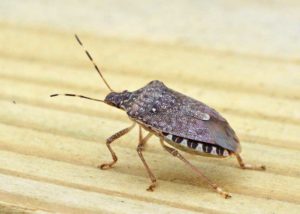(Note: All links below are to external websites and leave the UWM website.)
Salutations, BugFans,
The BugLady mentioned Brown Marmorated/Asian Stink Bugs briefly in a survey of stink bugs ten years ago, and she has been wondering what progress they had made since then. Veteran BugFans have probably noted that she uses the word “pest” sparingly (and never for native species), but the BMSB qualifies as a pest by most people’s yardstick.
Warning – the BugLady has possibly scored a personal best for clickable links in this episode.
Before we get started, stink bugs (family Pentatomidae) come in a variety of colors:
- https://bugguide.net/node/view/1932534/bgpage,
- https://bugguide.net/node/view/438992/bgpage,
- https://bugguide.net/node/view/1325451/bgimage,
with nymphs that are even more decorative than their elders; and in a variety of lifestyles. Some species are carnivores, but many are plant-eaters, and some rise to the level of being agricultural nuisances. Not every brown stink bug is a BMSB. Here are some species that are not: https://bugguide.net/node/view/613621/bgimage, and https://bugguide.net/node/view/1588384/bgimage. BMSBs have pale bands on their antennae.
 Brown Marmorated Stink Bugs (Halyomorpha halys) originally hailed from eastern Asia, but they’ve traveled to pretty much everywhere else on the globe – first in commercial shipments from China, and later in containers, cars, RVs, boxes of produce, etc. from newly-afflicted areas. (They can fly, too.) Their debut in North America was in Allenton, PA in 1998 (at a time when, as several sources point out, stink bugs were “not reportable.” The resulting lag gave them time to get a foothold in the New World (“creeping up on all sixes,” as Monty Python once said)). By 2009 they were well-established along the eastern seaboard and were moving inland, and by 2010, they had discovered the western Great Lakes. Here’s a recently updated map.
Brown Marmorated Stink Bugs (Halyomorpha halys) originally hailed from eastern Asia, but they’ve traveled to pretty much everywhere else on the globe – first in commercial shipments from China, and later in containers, cars, RVs, boxes of produce, etc. from newly-afflicted areas. (They can fly, too.) Their debut in North America was in Allenton, PA in 1998 (at a time when, as several sources point out, stink bugs were “not reportable.” The resulting lag gave them time to get a foothold in the New World (“creeping up on all sixes,” as Monty Python once said)). By 2009 they were well-established along the eastern seaboard and were moving inland, and by 2010, they had discovered the western Great Lakes. Here’s a recently updated map.
Marmorated means veined or variegated, like marble. Adults can be dark or pale, and the newly-molted adults are spectacular.
Males court by deploying aerial pheromones and by sending vibrations out through the substrate; if she’s willing, she vibrates back. She deposits barrel-shaped eggs (up to 400) in clusters on the undersides of leaves. The newly-hatched nymphs feed first on their egg shells, ingesting beneficial microbes that their mothers left there for them, which gives them the intestinal flora they will need to digest plant materials (it’s a little trick that’s known to other plant-eating stink bugs, too). There’s probably a single generation in Wisconsin, but there are multiple generations each year in the South, and they overwinter as adults.
They feed by inserting their sharp beak into plant tissue and sucking out the juices. For a great view of a BMSB’s business end, see this nice set of pictures. Their palate is catholic – they’ve been reported on at least 300 plant species, including orchard and field crops and ornamentals. While they’re waiting for the fruit to appear, they’ll happily suck liquids from stems and flowers (and later, seeds), but fruit eating is what they’re notorious for. The saliva they inject while feeding causes cosmetic damage called dimpling or “catfacing,” which makes fruits hard to sell, and their bites may introduce rot that doesn’t show until the fruit has been picked and stored for a while. Scroll down for pictures of insect damage. In 2010, at the start of the siege, damage to apple crops in the Mid-Atlantic States amounted to $37 million, and stone fruits were heavily impacted.
Reportedly, some native birds and insect parasitoids are learning that they’re edible, but like all stink bugs, BMSBs protect themselves by oozing a smelly, toxic liquid from glands on the thorax (it’s said to smell like strong cilantro or dirty gym socks or even rotting meat – odors that the BugLady never equated with each other – and it’s hard to wash off).
With so much at stake (and with BMSBs developing a resistance to a number of common pesticides), researchers have been working hard to find biological controls. After far too many hard-learned lessons (read “epic fails”), the process of finding a predator/parasitoid in an invasive species’ homeland, importing it, and letting it loose on our landscape has necessarily become more structured (example: imported tachinid flies that were released during much of the 1900’s to parasitize gypsy moth caterpillars turned out to prefer Luna moth caterpillars).
Scientists at Rutgers found a promising agent in the person of the samurai wasp from eastern Asia (scroll down for a shot of an adult wasp emerging from a BMSB egg, having nipped the nymph in the bud). In 2018, after several years of study, it appeared that the tiny (sesame-seed-sized) wasps would target only BMSBs. About the time that researchers were poised to release the wasps, some samurai wasps were discovered in the wild along the mid-Atlantic coast. They weren’t escapees (their DNA didn’t match the various strains being studied in laboratories); like a number of other biocontrol agents, they had, for better or worse, found their way here on their own.
BMSBs’ other bad habit involves their winter abode – which is your winter abode. To reverse the old saying, “Su casa es mi casa” (your house is my house). Like box elder bugs, BMSBs head inside when the weather turns frosty, sometimes in Biblical numbers, and they don’t need a very big gap in the siding or screen door to slip inside. The literature is full of accounts of people sweeping or vacuuming up thousands/tens of thousands of them in a single day.
They don’t bite, but they do stink, and they lodge in AC filters, and they hibernate in boots and coat pockets and closets. They awake as spring approaches and fly through the house, looking for an exit. A local newspaper recommends dedicating a small, hand-held vacuum to BMSB control (because a vacuumed up BMSB is a riled-up BMSB, and a riled-up BMSB is a smelly BMSB), emptying the full vacuum bag into a heavy trash bag and “taking it far from the house.” (and then???)
A decade ago, only a handful had been seen in Wisconsin.
BMSBs were first recorded in south-central Wisconsin around Madison area in 2010, and while their initial strongholds were in the Madison and Fox Valley areas, they spread to 28 counties during the next nine years. Wisconsin winters are not a problem for them.
At this point, there are not enough of them to do significant damage to fruit crops here, but they are poised in the wings, and Wisconsin grows an awful lot of apples, grapes, raspberries, and cherries (and corn and green beans and soybeans), all of which are on the BMSB’s menu. As always, good info and pictures at this site, including a shot of a dimpled peach.
The BugLady
